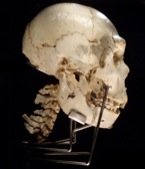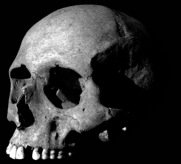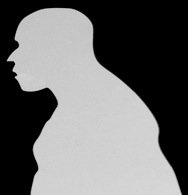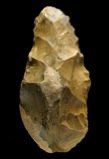Palaeoanthropology
Irish Neandertals!
03/12/09 22:23
This abstract from a 1961 paper made me smile:
Casey AE, Franklin RB. 1961. Cork-kerry Irish compared anthropometrically with 139 modern and ancient peoples. Irish Journal of Medical Science. 36 (9).
Living Cork-Kerry Irish were compared with 139 modern and ancient peoples using 36 factors, 14 blood groups, 3 skin, hair and eye pigmentations and 22 physical measurements. The method was a form of multiple correlation in which the class interval for each factor was one-half the standard deviation, and numerical values allocated to each half-standard deviation. The Irish, Northern Scots, Icelanders, S.W. Norse, N. Dutch and Frisians form a racial entity with 97 per cent. inter-correlation and very little change during the past 1,000–4,000 years. There is a high correlation with the ancient Scythians substantiating the Irish legends of descent from the kings of Scythia. There is a substantial mixture of upper palaeolithic and Neanderthal man in the north-western perimeter of Europe, exemplified by the people of Cork and Kerry, a mixture not shared by the American Indians, the Australian Aborigines, and by the Bushmen and Pygmies of Africa. There is a good possibility that the large frame, red hair, blue eyes and white skin of West Europe was contributed by upper palaeolithic and Neanderthal men.
Casey AE, Franklin RB. 1961. Cork-kerry Irish compared anthropometrically with 139 modern and ancient peoples. Irish Journal of Medical Science. 36 (9).
0 Comments
One chin does not a modern human make
21/11/09 22:04

Chinese scientists say that a recently discovered partial jaw from Guangxi challenges the ‘out of Africa’ model of modern human origins, while lending support to the multiregional hypothesis. The 110,000 year-old mandible is described as having a chin that juts “ever so slightly outward.” These scientists assert that the presence of chin shows that there was significant gene flow between populations of modern Homo sapiens and archaic Homo.
Wu Xinzhi of the Chinese Academy of Sciences had the following to say about the find:
”The finding was strong evidence to prove the multiregional model, and from this evidence, it was significant to solve the academic dispute between 'the multiregional mode' and 'out of Africa theory’”.
It is interesting to note Xinzhi’s use of the past simple tense to suggest that this is a closed case. Far from it! Palaeoanthropological theory has moved on from the multiregional sensu stricto versus ‘out of Africa’ sensu stricto dichotomy that predominated the discussion during the latter half of the last century. Nevertheless, the question of how much gene flow, if any, took place between modern and archaic Homo is still very much a debated issue. Read More...
Full frontal hominins
05/11/09 22:43
One of the most visually striking differences between modern humans and other hominins is the shape of the forehead. The frontal bone of the forehead serves two primary functions: it houses the frontal lobes of the brain in the anterior cranial fossa and also forms the orbital roof. When the orbits are positioned anterior to the frontal lobes, a supraorbital torus or brow ridge, forms in order to bridge the gap. This is particularly the case in archaic members of the genus Homo, whose brain cases are positioned well behind their faces.
The incredible brow ridges of Homo erectus is perhaps this species most salient physical feature. They possess a flattened forehead with a bar-like brow ridge over the eye sockets. The supraorbital torus is continuous and thickened laterally, which in turn is associated with a pinching of the orbital breadth behind the eye sockets, known as postorbital constriction. In H. erectus, the supraorbital torus is separated from the frontal squama by a depression called the posttoral sulcus. While most Erectines conform to this general bauplan, there is a lot of regional variation in the exact form of the torus.
Neandertals are characterised by their long, large, low and wide skull. They have a double-arched browridge above the orbits, which angles backward on the sides of the face. It is depressed along the middle by the presence of a supraglabellar fossa. Compared to H. erectus, Neandertals have a more vertical and rounded forehead, with a less pronounced supraorbital torus. Read More...
The incredible brow ridges of Homo erectus is perhaps this species most salient physical feature. They possess a flattened forehead with a bar-like brow ridge over the eye sockets. The supraorbital torus is continuous and thickened laterally, which in turn is associated with a pinching of the orbital breadth behind the eye sockets, known as postorbital constriction. In H. erectus, the supraorbital torus is separated from the frontal squama by a depression called the posttoral sulcus. While most Erectines conform to this general bauplan, there is a lot of regional variation in the exact form of the torus.
Neandertals are characterised by their long, large, low and wide skull. They have a double-arched browridge above the orbits, which angles backward on the sides of the face. It is depressed along the middle by the presence of a supraglabellar fossa. Compared to H. erectus, Neandertals have a more vertical and rounded forehead, with a less pronounced supraorbital torus. Read More...
Did Neandertals and modern humans interbreed?
27/10/09 19:36
Ever since William King proposed the taxonomic designation Homo neanderthalensis in 1864, there has been intense debate as to whether Neandertals represent a distinct species from us. Species, as defined by the biological species concept, are populations of organisms that can potentially interbreed and have fertile offspring. It is believed that the lineage leading to Neandertals and modern humans split sometime around 500,000 years ago. For most of their existence Neandertals and early modern humans were geographically isolated (and by extension reproductively isolated) from one another. The big question is whether they could have produced viable offspring when they met.
Today, most researchers acknowledge that some sexual encounters could have occurred between Neandertals and modern humans. The more interesting question is how common were these encounters and did they leave their mark on the modern gene pool. Undoubtedly, modern humans and Neandertals would have recognised each other as fellow humans but this does not mean that they would have acted humanely to each another. Countless social and psychological studies have shown humans to have a very strong "us versus them" mentality, that no doubt also existed in our ancestors. It is unlikely that modern humans and Neandertals had an easy relationship. Most sexual encounters that took place between the two were likely opportunistic and probably involved enslavement and rape. Read More...
Today, most researchers acknowledge that some sexual encounters could have occurred between Neandertals and modern humans. The more interesting question is how common were these encounters and did they leave their mark on the modern gene pool. Undoubtedly, modern humans and Neandertals would have recognised each other as fellow humans but this does not mean that they would have acted humanely to each another. Countless social and psychological studies have shown humans to have a very strong "us versus them" mentality, that no doubt also existed in our ancestors. It is unlikely that modern humans and Neandertals had an easy relationship. Most sexual encounters that took place between the two were likely opportunistic and probably involved enslavement and rape. Read More...
Homo heidelbergensis and the muddle in the middle
10/10/09 20:45

At the conference, much attention was focused on the Middle Pleistocene "muddle in the middle" [3], particularly the role of Homo heidelbergensis in hominin evolution. While H. heidelbergensis possesses both archaic and derived traits intermediate between H. erectus and later members of the Homo genus, it lacks uniquely derived traits or autapomorphies, which are a prerequisite for defining a species.
H. heidelbergensis has traits that have been interpreted as nascent Neandertal autapomorphies, leading some researchers to propose that there was a continuous evolution of Neandertals [4-6]. This accretion model would make H. heidelbergensis a chronospecies on the continuum of the Neandertal lineage, a view championed by Jean-Jacques Hublin. The accretion model proposes that Neandertals evolved by anagenesis, i.e. non-branching evolutionary change. Read More...
The pelvis of Ardipithecus ramidus
02/10/09 15:04

One of the anatomical features that sets humans apart from other living primates is the shape of our pelvis. The shift from a quadrupedal aboreal lifestyle to habitually walking on two legs requires a substantial reconfiguration of the hip region. The 4.4 million year old Ardipithecus ramidus fossil remains give us a glimpse of what the one of the earliest members of the hominin lineage looked like. While the feet of Ar. ramidus show that it was still adapted to life in the trees, the pelvis shows significant adaptations to walking upright on two legs.
The gluteus maximus, which is a relatively minor muscle in quadrupeds has been reconfigured into the largest muscle in humans, in order to stabilize the pelvis and trunk in an upright position. The derived nature of the ilium of Ar. ramidus suggests that the enlargement of the gluteal maximus had already begun. The craniocaudal height of the pelvis is also reduced, which would have lowered the relatively long trunk's centre of mass. This would have allowed for more stable bipedal locomotion. Read More...
Fossil and data access in palaeoanthropology
08/09/09 22:50
A recent article in Scientific American has generated a lot of buzz in the anthropology blogosphere. The piece discusses the problems of accessing human fossil remains, reopening the discussion on how open anthropology needs to be. The reason why data acquisition is such a problem in palaeoanthropology is captured in the opening sentence of an article Stephen Jay Gould and David Pilbeam wrote for Science:
Whenever supply cannot keep up with demand, you can be sure that problems will follow. (Many parents have learned this to their chagrin, when they find out that the Christmas toy du jour, their beloved child so wanted, is sold out.) Each newly unearthed fragment of human bone represents yet another valuable piece in the ever-growing jigsaw puzzle that is our evolutionary history. The study of primary data is of prime importance in paleoanthropology. As a result, a conflict arises, due to the need to study fossils and the limited access placed upon them. Restricted access occurs for a number of reasons, ranging from valid concerns over the fragility of a particular specimen, to scientists reaping the benefits of a research monopoly.
There is an unwritten rule in palaeoanthropology that the discoverers of a fossil have the exclusive rights to publish the initial monograph describing their specimen. Palaeoarchaeologists invest a lot of resources, time and effort in recovering fossils. They will often literally risk body and limb. Dehydration, food poisoning, snake bites, diseases and infections are but some of the hazards field archaeologists face. When they are not digging they are often engaged in the uneviable task of writing grants for their projects. It is understandable that they are wary of outsiders who expect free access to their hard-won prizes. Read More...
"Human paleontology shares a peculiar trait with such disparate subjects as theology and extraterrestrial biology: it contains more practioners than objects for study."
– Stephan J. Gould and David Pilbeam
Whenever supply cannot keep up with demand, you can be sure that problems will follow. (Many parents have learned this to their chagrin, when they find out that the Christmas toy du jour, their beloved child so wanted, is sold out.) Each newly unearthed fragment of human bone represents yet another valuable piece in the ever-growing jigsaw puzzle that is our evolutionary history. The study of primary data is of prime importance in paleoanthropology. As a result, a conflict arises, due to the need to study fossils and the limited access placed upon them. Restricted access occurs for a number of reasons, ranging from valid concerns over the fragility of a particular specimen, to scientists reaping the benefits of a research monopoly.
There is an unwritten rule in palaeoanthropology that the discoverers of a fossil have the exclusive rights to publish the initial monograph describing their specimen. Palaeoarchaeologists invest a lot of resources, time and effort in recovering fossils. They will often literally risk body and limb. Dehydration, food poisoning, snake bites, diseases and infections are but some of the hazards field archaeologists face. When they are not digging they are often engaged in the uneviable task of writing grants for their projects. It is understandable that they are wary of outsiders who expect free access to their hard-won prizes. Read More...
Upper Palaeolithic Italy
23/08/09 14:21

Extrapolating from data by Bocquet-Appel et al. (2005) it is possible that the population of Italy did not exceed 1,000 inhabitants. While this figure is little more than a best guess, it still gives us an idea of the fragile nature of these groups, who were living constantly on the edge of extinction. With such small numbers inbreeding can become a serious problem. However, studies of European Upper Palaeolithic people find them to be surprisingly homogenous as a whole, which would suggest a significant amount of gene flow between far-flung populations (Henke 1989, 1991). In order to understand how mating systems would have operated during the Early Upper Palaeolithic researchers have looked to modern hunter-gatherer groups. Such studies have found hunter-gatherers to have less group closure than agriculturalists. This would have been an important survival strategy for the hunter-gatherer groups of the Upper Palaeolithic, especially when faced with unpredictable environmental conditions and already constrained mating networks. This open network is also reflected in the material culture from this period. Venus figurines, dating chiefly from the Gravettian period, have been found over an area of approximately 2000 km, spanning from modern day Russia in the Northeast to Spain in the Southwest. The Italian Venuses from Savignano, Balzi Rossi and Parabita show the same female form, with an enlarged midsection, pronounced buttocks, large breasts and voluminous thighs, characteristic of the vast majority of these figurines. This suggests that there was an extensive flow of people and ideas during the Early Upper Palaeolithic. This is further supported by the transport of exotic materials, such as flint and shells over distances of several hundred kilometres. Read More...
Who made the Aurignacian?
31/05/09 00:40
Until recently, it was largely assumed that the Aurignacian was contemporaneous with the arrival of anatomically modern humans in Europe sometime around 40,000 years ago. This industrial complex is named after the site of Aurignac in southern France and is found throughout Europe and southwest Asia. The evidence for an association between modern humans the Aurignacian has been less than clear cut.
For most of the last century, the prevalent view among archaeologists was that Neandertals only made Mousterian tools. However, the discovery of the St Césaire 1 Neandertal skeleton and the Neandertal remains from Arcy-sur-Cure with Châtelperronian industry put paid to this idea. Châtelperronian tools show a mix of features otherwise found in the Mousterian and Aurignacian industries. What was particularly surprising about the Châtelperronian culture was not only the lithics but also the manufacture of bone tools and personal ornaments. At the site of Arcy-sur-Cure archaeologists found pierced teeth, ivory, shell, and bone in the Châtelperronian layers. The Szeletian industry of central Europe and the Uluzzian industry of Italy may also be related to the Châtelperronian.
Read More...
For most of the last century, the prevalent view among archaeologists was that Neandertals only made Mousterian tools. However, the discovery of the St Césaire 1 Neandertal skeleton and the Neandertal remains from Arcy-sur-Cure with Châtelperronian industry put paid to this idea. Châtelperronian tools show a mix of features otherwise found in the Mousterian and Aurignacian industries. What was particularly surprising about the Châtelperronian culture was not only the lithics but also the manufacture of bone tools and personal ornaments. At the site of Arcy-sur-Cure archaeologists found pierced teeth, ivory, shell, and bone in the Châtelperronian layers. The Szeletian industry of central Europe and the Uluzzian industry of Italy may also be related to the Châtelperronian.
Read More...
A little human with very big feet
13/05/09 11:50

The pelvis and legs all clearly demonstrate that Homo floresiensis was bipedal. However, the hominin’s feet are unusually long compared to the leg. This combination of a long foot and a relatively short leg is seen in some apes but not in hominins. The navicular acts like the keystone in the arch of the human foot and is elevated from the ground except in people who have fallen arches. Read More...






